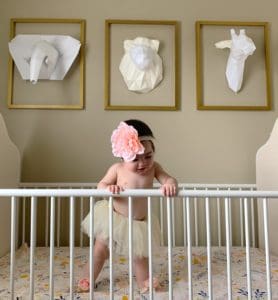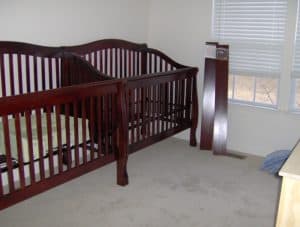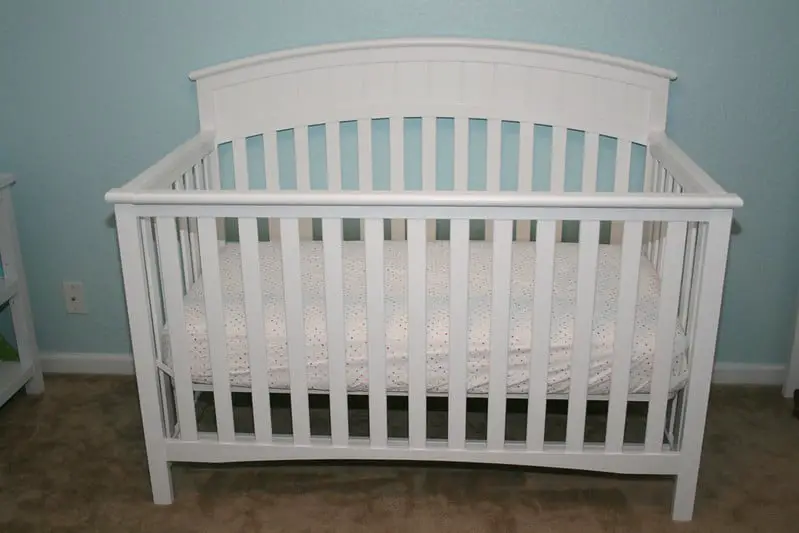Well, since this is a crucial undertaking in ensuring your baby’s comfort, you might be having a lot of unanswered questions when it comes to selecting the safest way to do it.
Before you wind up your nursery plan, ensure that you put in mind what is safe for your baby’s room and what is not.
There are many positions you can set your baby’s crib with the vent.
One that gives the little one optimum comfort should be your choice.
Can You Put A Crib Over A Floor Vent?
Yes. You can position the baby’s crib over a floor vent and ensure maximum comfort for your baby. In this guide, we go into deep details on how exactly you can do this and other interesting facts that revolve around your baby’s comfort. You have to be careful not to put the crib too close to the heating or air vent. The problem here is that the air will blow directly to the baby and makes their breathing difficult. Besides, it also proves very difficult for them to balance their body temperatures. The trick here lies in knowing how to keep the crib out of the direct flow of air.
What’s The Ideal temperature to Maintain in a Baby’s crib?
Before we get far, it would be a prudent idea to get acquainted with the appropriate temperature to maintain in the baby’s crib.
Remarkably, our bodies are capable of adjusting to the temperatures in our environments. It is, therefore, possible to remain comfortable in a varying range of temperatures.
With young children, their bodies have not mastered this ability very well. This calls for the utmost attention to ensure that their comfort is guaranteed.
Babies lose heat three times faster than adults when exposed to cold conditions. At the same time, they risk getting overheated when subjected to conditions that are too warm.
Your baby has to be in a well-rested and comfortable crib. Experts recommend temperatures between 20 to 22˚C (68 to 72˚F). This temperature should serve as a reference point for you when setting the baby’s crib with the heating or air vent.
Should You Adjust The Baby’s Crib Temperatures During Winter And Summer?

Well, hot summer temperatures are linked to increasing Sudden Infant Death Syndrome (SIDS) due to overheating.
While maintaining the room temperature in the crib between 20-22 ˚C, using lighter clothing or pajamas is the trick here.
You could use a cooler or a portable fan if temperatures are extreme.
It is noteworthy that the fan or cooler should face away from the baby’s crib. Avoid direct airflow that might compromise the baby’s breathing and general health.
During winter, maintain the crib’s temperature at 20-22˚C as well.
A thermostat should be doing this for you. Regulate it appropriately. Resist the temptation to over-bundle the baby.
This can cause overheating and suffocation. Just make the temperature a little warmer by using some heavy clothing or pajamas. Be moderate enough.
Three Precautions When Putting the Crib OVER an Air Vent


Keeping the baby away from direct air vents is important to avoid direct exposure to a line of air. When positioning the crib over the vent, be mindful of the following:
1. The Baby’s Body Temperature
Your baby’s body temperature is gradually learning how to regulate temperature. If you blast the baby with lines of cold air, you pose SIDS risks to the little one. Besides, your baby can get grumpy and cold.
2. Dry air
Without a proper check, the air vent can dry out the air in the baby’s crib. This leads to baby sniffles and a stuffy nose.
3. Allergies And Other Respiratory Illness
Air vents facilitate the circulation of air in the entire room. If there are allergens somewhere in the room, it can be circulated by air currents and blown towards the baby’s crib.
This poses a respiratory risk to the baby. Other people in the room can also fall prey to respiratory illnesses and allergic reactions. Locating the air vent too direct to the crib puts the baby in danger of inhaling particles and allergens.
Three Precautions When Putting the Crib UNDER A Heating Vent
You need to avoid the direct placement of a heating vent into the baby’s crib. If you do it, do it with ultimate watchfulness.
Also, consider putting it some distance away from the crib. Monitor the flow of air in the vent. When using a heating vent over the baby’s crib, take note of the following:
1. Dehydration
Extremely warm temperatures cause a lot of sweating which potentially dehydrates the baby.
Placing the heating vent directly and near the baby’s crib poses the risk of dehydration.
2. Furniture damage
Possible drying out and cracking can occur when the wood is exposed to high temperatures.
A heating vent can cause this effect. It might be negligible but it happens with time. It is important to mind the child’s safety in every aspect.
3. The baby’s body temperature
Heating vents blast hot air on the baby which leads to overheating. Your baby will get very uncomfortable. Worse still, if the baby remains in this condition for a long time, SIDS can occur.
Covering A Heating Vent
When a heating vent is covered with any kind of furniture, cool air is blocked from flowing into the furnace.
Overheating will, in turn, take place inside the furnace. If the situation persists, it will crack. This will cost you expensive repairs.
Worse still, it can cause a fire. You have to be careful when using a heating vent to ensure that there is enough airflow in it. It makes it durable and keeps fire dangers at bay.
Can You Avoid Positioning The Crib Near The Vent?
Well, baby cribs will take more space than you would expect.
Without proper planning, it might even not fit into the baby’s room. If you are having your first baby, you need to do proper planning on the same. It is going to be an incredible experience.
Here are ways to help keep your little ones safe in the crib.
1. Using A Vent Deflector
Vents deflectors are innovations designed for the top part of your cooling and heating vent. They also serve to redirect the line of airflow so that it doesn’t blow up.
Vent deflectors are available in varied designs. Look for one that fits your vent.
Choosing a vent deflector is a big step in ensuring your child gets a comfortable stay in the crib.
It will serve to regulate the direct flow of hot or cold air from the vent. Essentially, your child is barred from receiving direct airflow which can compromise its safety.
2. Close The Vents Under The Baby’s Crib
Vents can be easily closed as a way of regulating the crib’s temperature. If you are positioning the crib over the vent, closing it before setting up the furniture is a prudent idea.
This is a smart way to make sure that hot or cold air does not flow directly on the baby. When you close all the vents in the baby’s room, properly check the temperature in it.
When vents are closed, it might prove very difficult to balance the cold and warmth in the room.
In such circumstances, a thermostat will play an integral role.
Alternatively, you can set up a fan in the baby’s room to ensure air recirculation.
This will still maintain a healthy environment for the baby.
3. Put The Baby’s Nursery In Order
It can be a boring undertaking but it is worth it. Interfering with the nursery’s original plans might be the last thing in your mind but you need to reconsider doing it.
If you don’t want to move the baby’s crib away, put it in a safe place. It can pose accidents.
The goal is to make sure your baby is in safe conditions. So if you are prompted to reorganize, you shouldn’t hesitate to do that.
4. Purchase A Quality Crib


If you find that your existing crib is making it hard to position a vent on, over, or near it, getting a really good crib is the only option.
Acquire a crib that can handle the job and boost your child’s temperature with a vent over it. Your crib should be set in such a way that any drafts coming from the vent are directed to the furniture rather than on the baby.
To tame any unwanted breeze, your crib slats should be close together.
It is also recommended to acquire a solid, wooden baby crib since it provides proper insulation between the blowing air and the child.
Final Thoughts
Your child’s comfort should be your priority.
Investing in a good crib and ensuring a proper installation of a vent is a good step in achieving that goal. Set everything in the right position.
Also, aim for a good mattress that is firm enough.
Better still; make sure the mattress has a waterproof cover as this will keep the crib warm from the underside. Finally, armor the baby with the right sleepwear.


